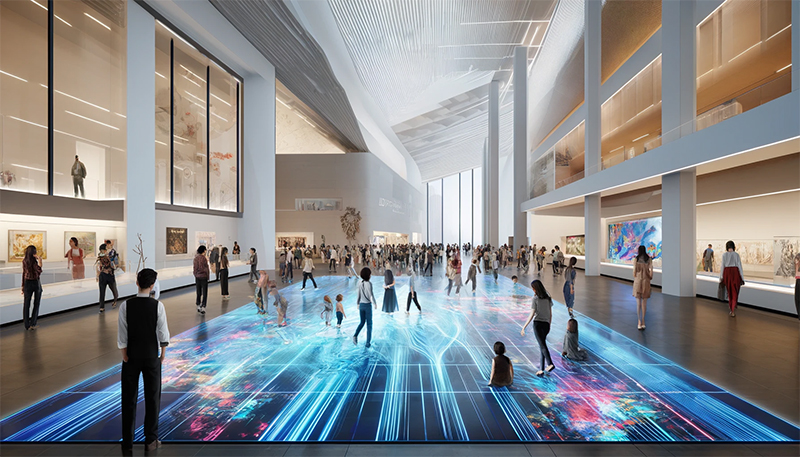Views: 0 Author: Site Editor Publish Time: 2024-12-16 Origin: Site








Sensor LED floors use various types of sensors to detect user interactions, such as movement, pressure, or touch, and trigger corresponding visual responses on the LED display. These sensors enable the floor to be interactive, dynamic, and responsive to real-time inputs. Here are the most common types of sensors used in Sensor LED floors:
Function: Pressure sensors are the most commonly used sensors in LED floors. They detect the force or weight applied to a specific area of the floor. When a person steps on the floor, the sensor detects the pressure and activates a visual response on the LED display (e.g., changing colors, shapes, or animations).
Applications:
1. Detecting footsteps or movement.
2. Interactive games or activities that require users to step on specific areas.
3. Pathways or wayfinding guides where the floor reacts to each person’s position.
Advantages: Pressure sensors are reliable and can be highly sensitive to detect light or heavy footfalls.
Function: Motion sensors detect the movement of objects or people in proximity to the floor. These sensors don’t necessarily require direct contact or pressure, but instead, they capture changes in the surrounding area as someone moves over or near the floor.
Types of Motion Sensors:
1. Infrared (IR) Sensors: These sensors use infrared light to detect the presence or motion of a person. When someone moves, the sensor detects the heat signature and activates the LED system.
2. Ultrasonic Sensors: These emit sound waves and detect the return echo from objects or people moving above the floor.
3. Passive Infrared (PIR) Sensors: Commonly used in motion detection, PIR sensors detect infrared light emitted from living beings and activate the floor in response to detected movement.
Applications:
1. Event spaces where users move across the floor, triggering visual effects.
2. Interactive displays that respond to nearby motion or gestures, such as for museums or retail spaces.
Advantages: Motion sensors are ideal for non-touch interactions and can detect multiple people at once.

Function: Touch sensors detect direct contact with the floor’s surface, usually through capacitive, resistive, or infrared technology. When a person touches or presses on the floor, it triggers a visual change.
Types of Touch Sensors:
1. Capacitive Sensors: Detect changes in capacitance when a person touches the floor. These are commonly used in touch screens and can detect the location of a finger or hand.
2. Resistive Sensors: These sensors change their resistance when pressure is applied. They are less common in LED floors but can still be used for specific applications.
3. Infrared (IR) Touch Sensors: Utilize infrared light and sensors to detect touch or proximity on the floor’s surface.
Applications:
1. Interactive games or educational tools that require specific touch interactions.
2. Interactive displays in museums, exhibitions, or interactive marketing campaigns.
Advantages: Touch sensors allow for precise control, ideal for user-driven input like selection or navigation.
Function: Proximity sensors detect the presence of an object or person without physical contact, typically through electromagnetic fields, capacitive, or ultrasonic technology.
Types of Proximity Sensors:
1.Capacitive Proximity Sensors: Detect the presence of a person by sensing changes in the electric field as someone approaches the floor.
2.Inductive Proximity Sensors: Detect metallic objects or persons (if they have metal items on them) based on changes in the magnetic field.
Applications:
Used in scenarios where you want to activate the floor when a person approaches without them having to touch it or step on it.
Advantages: They are useful for creating interactive experiences that respond as people approach, without needing them to physically touch the floor.

Function: Optical sensors use light-based technology, such as infrared or laser beams, to detect motion or touch. These sensors detect changes in light patterns or interruptions caused by physical objects (such as a footstep or a hand) passing over the floor.
Applications:
1. Environments where high-precision motion detection is needed, such as in interactive exhibits or high-traffic areas.
2. Retail or exhibition spaces where customers can interact with the floor without physically touching it.
Advantages: Optical sensors offer non-contact detection, making them less prone to wear and tear from physical contact.
Function: Weight or force sensors detect the actual weight applied to the floor, and the floor’s response varies based on how much force is applied.
Applications:
1. Floors that respond differently to heavy or light footsteps, creating varying visual effects depending on the user's weight.
2. Used in games or interactive installations where force is required to trigger certain animations or events.
Advantages: These sensors are very accurate in determining the intensity of a user’s interaction with the floor.
Function: Temperature sensors detect changes in the surrounding environment. These are less common in LED floors but may be used in specialized installations to respond to heat signatures or the presence of people.
Applications:
Used in interactive displays where the floor may react to the heat from human bodies or objects placed on it.
Advantages: They can add another layer of interactivity based on environmental factors like temperature.
The choice of sensor for a Sensor LED floor depends on the desired interactivity and the type of experience you want to create. Pressure sensors are the most commonly used for detecting footsteps, while motion and touch sensors offer different forms of interaction, such as responding to movement or direct contact. Proximity, optical, and weight sensors are used to enhance the floor’s responsiveness in various creative applications, providing a wide range of possibilities for interactive environments. Each type of sensor contributes to the floor’s ability to provide dynamic, engaging, and customized user experiences.